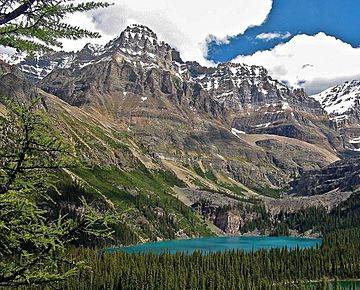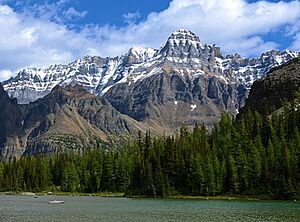Mount Huber facts for kids
Quick facts for kids Mount Huber |
|
|---|---|

Mount Huber seen above Lake O'Hara
|
|
| Highest point | |
| Elevation | 3,348 m (10,984 ft) |
| Prominence | 158 m (518 ft) |
| Parent peak | Mount Victoria (3464 m) |
| Geography | |
| Location | British Columbia, Canada |
| Parent range | Canadian Rockies |
| Topo map | NTS 82N08 |
| Geology | |
| Age of rock | Cambrian |
| Type of rock | Limestone |
| Climbing | |
| First ascent | 1903 George Collier, E. Tewes, Christian Bohren, Christian Kaufmann |
| Easiest route | Scrambling class 4 |
Mount Huber is a tall mountain in the Canadian Rockies. It stands 3,348 meters (about 10,984 feet) high. This impressive peak is located in Yoho National Park in British Columbia, Canada. It's just two kilometers east of the beautiful Lake O'Hara. Mount Huber is actually a smaller part of a bigger mountain called Mount Victoria.
How Mount Huber Got Its Name
Mount Huber was named in 1903. It was named after a Swiss climber named Emil Huber. Emil Huber was famous for being one of the first people to climb Mount Sir Donald in the Selkirk Mountains.
The very first time someone successfully climbed Mount Huber was also in 1903. This climb was done by George Collier, E. Tewes, Christian Bohren, and Christian Kaufmann. The mountain's name became official in 1924. This happened when the Geographical Names Board of Canada approved it.
What Mount Huber Is Made Of
Mount Huber is made of special rocks called sedimentary rocks. These rocks were formed over millions of years. They were laid down in shallow seas during ancient times. This happened from the Precambrian to the Jurassic periods.
Later, during a time called the Laramide orogeny, these rocks were pushed up. This powerful movement created the mountains we see today.
Weather Around Mount Huber
Mount Huber is located in a subarctic climate zone. This means it has very cold, snowy winters. Summers are usually mild. Temperatures can drop below −20 °C (which is −4 °F). With wind, it can feel even colder, sometimes below −30 °C (−22 °F).
The snow and rain that fall on Mount Huber flow into streams. These streams then join the Kicking Horse River. The Kicking Horse River is a branch of the mighty Columbia River.




